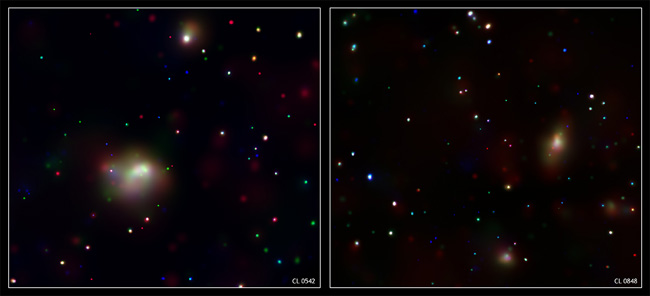
Like gluttonous piranhas, supermassive black holes in young galaxy clusters gorge on bountiful gas until little fuel is left, and then they fade away, a new study suggests.
Using NASA's Chandra X-ray Observatory, astronomers tallied the number of rapidly growing supermassive black holes, called active galactic nuclei, or AGN, in two populations of galaxy clusters.
One group consisted of young-looking clusters located very far from Earth, and the other consisted of an older group located closer to us.
The results of the survey, detailed in the July 20 issue of The Astrophysical Journal Letters, showed that the more distant, younger clusters contained about 20 times more AGN than nearer ones.
Fade with time
The implication, said study team member Paul Martini of Ohio State University, "is that when clusters were young, there were much more AGN present in the cluster galaxies. As the clusters galaxies continued to evolve, the AGN faded away."
By this reasoning, the researchers predict that clusters with ages between the two groups studied would have an intermediate amount of AGN, while older clusters would have even more AGN.
Get the Space.com Newsletter
Breaking space news, the latest updates on rocket launches, skywatching events and more!
As clusters age, less gas fuel is available for their AGN to consume and they become less active. "Really it's the activity of the black hole that has faded away," Martini told SPACE.com. "The black hole is still there and the galaxy is still there as well. It's just the activity that we see from the black hole has diminished a great deal."
Galaxies that are not part of clusters have a constant, if slow, trickle of intergalactic gas falling onto them, which they use to replenish their gas reserves and continually form new stars. The spaces between galaxies that are part of clusters, however, are filled with hot, rarified gas that does not get incorporated into the individual galaxies very efficiently.
Starving galaxies
"There's no freshening of the gas in the cluster galaxies themselves," Martini said.
As a result, galaxies in clusters become starved of gas over time, and black hole activity and star formation in these galaxies slows.
An average-sized galaxy contains about 100 billion stars, and a single galaxy cluster contains several hundred galaxies. However, only a few of the cluster's galaxies contain AGN.
All of these objects—stars, black holes, galaxies and galaxy clusters—can crash and merge with one another. When clusters collide, the amount of energy generated is second only to the Big Bang event scientists think gave birth to the universe.
- Vote Now: The Strangest Things in Space
- VIDEO Animation: Slow Birth of a Black Hole
- Bevy of Black Holes Found in Galaxy Cluster
Join our Space Forums to keep talking space on the latest missions, night sky and more! And if you have a news tip, correction or comment, let us know at: community@space.com.
Ker Than is a science writer and children's book author who joined Space.com as a Staff Writer from 2005 to 2007. Ker covered astronomy and human spaceflight while at Space.com, including space shuttle launches, and has authored three science books for kids about earthquakes, stars and black holes. Ker's work has also appeared in National Geographic, Nature News, New Scientist and Sky & Telescope, among others. He earned a bachelor's degree in biology from UC Irvine and a master's degree in science journalism from New York University. Ker is currently the Director of Science Communications at Stanford University.












